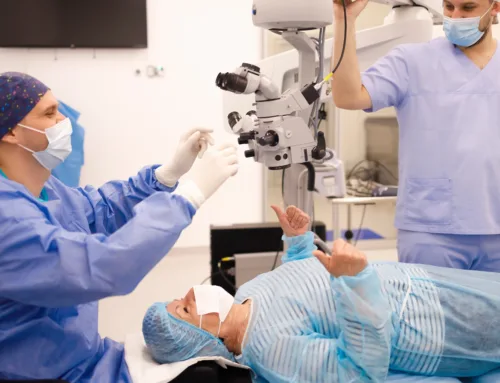Astigmatism is one of the most common causes of blurry vision. Millions have astigmatism… In fact, almost everyone has at least a little bit of astigmatism. Some people have more of it… and others have less. Regardless of how much astigmatism you have, if uncorrected, astigmatism will cause you to have blurry vision. Did you know that you can have your astigmatism fixed during modern cataract surgery? Here we will dive into how cataract surgery with a toric lens implant can fix your astigmatism.
By fixing your astigmatism during cataract surgery, you will be able to free yourself from the need for glasses or contact lenses to fix the problem.
In this article, we’ll review what astigmatism is, and more importantly, how it can be fixed during cataract surgery with treatments, such as toric intraocular lens implants and arcuate incisions.
What Is Astigmatism?
Astigmatism refers to the shape of a lens being more like a football (or, technically speaking, an ellipsoid)… than a basketball (or a sphere).
For a lens to focus light equally across its entire surface, it should be shaped like a sphere.
However, nature isn’t perfect.
The function of the front part of our eyes is to focus light on to the back part of the eye. That is, the function of the cornea, and natural lens inside the eye, are to focus light onto the retina, which acts like the film in the back of a camera.
The combination of this “two-lens system” often is not perfectly spherical. Sometimes astigmatism comes from the cornea. Other times it comes from the natural lens. Many times it comes from both.
If this irregular curvature of your natural cornea and lens system is not corrected, it will cause blurry vision.

What Causes Astigmatism?
Good question… The cause of astigmatism is complex and not fully understood. Like so many disorders, there appear to be both genetic and environmental factors.
A study from Singapore found the number of hours spent playing video games in children aged 7 to 9 years old was associated with more severe astigmatism.
Eye rubbing has long been associated with irregular astigmatism and severe forms of astigmatism, such as keratoconus.
Genetic factors appear to also be related. Studies have shown that the risk of developing astigmatism in first-degree relatives of those with astigmatism doubles, compared to first-degree relatives of those who do not have astigmatism.
If you are a patient over the age of 50 considering cataract surgery, there’s not much you can do to change the shape of your cornea at this point. Aside from severe eye rubbing, most patients’ cornea doesn’t change shape as they get older. Most people’s corneal astigmatism stabilizes by the age of 18. As we age, the effect of UV light on the cornea stabilizes, or “locks in” its shape for most people.
Are There Different Types Of Astigmatism?
Yes… There are different types of astigmatism.
One way to classify astigmatism is by where it’s located… Astigmatism can be found in either the cornea or the natural lens.
During cataract surgery, the natural lens is removed, so the only astigmatism that you’ll be left with is from your cornea. That means, if you plan on fixing your astigmatism during cataract surgery, it’s your corneal astigmatism that needs to be measured and treated.
The other way to classify corneal astigmatism is as “regular” or “irregular”.
Regular astigmatism means that your cornea is shaped like a perfect football. That means that if you sat a football on a table, and you looked at its curvature, you would find that along the long axis of the football, the curvature is flatter, and along the shorter axis, you would find that the football has a steeper curvature.
A corneal with irregular astigmatism does not have to conform to this football shape. A corneal with irregular astigmatism can have an irregular contour with different zones of steeper or flatter curvature.

Figure (Left): Regular astigmatism. Notice how the cornea is steeper vertically and the vertical colors are symmetric from the top versus bottom. (Right): Irregular astigmatism. Notice how the bottom part of the cornea is much steeper than the top.
How Is Astigmatism Fixed?
Astigmatism can be fixed in a variety of ways including, glasses, contact lenses, laser vision correction (e.g. LASIK), or modern cataract surgery.
Each treatment works in a slightly different way.
For example, glasses fix the irregular focusing of your eye due to the steep curvature of your cornea and lens, by counterbalancing it by having you look through a glasses lens that is shaped to be flatter along the steep axis of your cornea.
Soft contact lenses work similarly to glasses. However, hard contact lenses vault over the irregular shape of your cornea to cover up this irregular contour.
In LASIK, the laser reshapes the curvature of the cornea to treat the overall astigmatism of the eye.
In cataract surgery, there are two ways to treat astigmatism, which we’ll get into more detail in the next section. These are 1.) toric lens implants, and 2.) limbal relaxing incisions.
How Does Cataract Surgery Treat Astigmatism?
The first step to treating your astigmatism with cataract surgery is to measure your corneal astigmatism.
Recall that your overall astigmatism is the sum of the astigmatism in your cornea, plus the astigmatism in your natural lens. Because your natural lens is removed during cataract surgery, the only astigmatism that’s left is the astigmatism in your cornea.
In modern cataract surgery, your surgeon will measure the shape of your cornea with specialized diagnostic devices. Depending on how much astigmatism you have in your cornea, your surgeon may decide to fix it by either: 1.) implanting a toric lens implant, or 2.) changing the shape of your cornea.
Changing the shape of your Cornea
For lower levels of astigmatism “relaxing incisions” or “laser arcs” can be used to change the shape of your cornea. Placing these incisions relative to the steep axis of your cornea, they have the effect of flattening the steep portions. This results in a more spherical shape of the cornea.
These “relaxing incisions” have been performed for decades with precise blades, and are very accurate.
More recently, laser cataract surgery systems can precisely perform this re-shaping of the cornea without the need for blades. These “laser arcuate incisions” are extremely precise in their positioning, depth, and overall effect on fixing astigmatism.

Implanting a Toric Lens Implant
For higher levels of astigmatism, it’s more accurate and consistent to have the astigmatism correction built into the lens implant itself. Toric lens implants have been around for many years and the implantation, alignment, and positioning is routine for experienced surgeons. Toric implants can correct much higher levels of astigmatism compared to limbal relaxing incisions.
 Figure: Toric lens implant to fix astigmatism. Notice the 3 little dots by the “arms”. These help the surgeon position the toric implant properly.
Figure: Toric lens implant to fix astigmatism. Notice the 3 little dots by the “arms”. These help the surgeon position the toric implant properly.Toric lens implants work similarly to how a glasses lens fixes your astigmatism… except for the convenience of having it implanted in your eye so that you don’t have to rely on glasses or contacts to see clearly. All adult patients have a lens implant placed at the time of their surgery, so the only decision to make is whether you want a modern toric lens implant that fully corrects your vision or a basic lens implant that does not fully correct your prescription.
Should You Have a Toric Lens Implant To Fix Your Astigmatism?
The decision about whether to have a toric lens implant or not should be based on a discussion with your surgeon.
The main decision that you should make is: “How do you want your vision to look after surgery?”
That is… do you want your vision to be clear for distance activities like driving, watching television, and outdoor activities? Or would you prefer for your vision to be clear for near vision activities like reading? Or would you like both?
Check out our article on Cataracts 101 for more details on how to think about lens implant options.
Said in another way: What’s most important to you is how your vision looks after surgery… You should not care if the surgery uses a toric lens, a non-toric lens, or which brand they use. Based on the measurements of your eye, some surgeons may prefer different models of lens implants and will have different cut-offs for when they use a limbal relaxing incision versus a toric IOL.
Conclusion
Toric lens implants are a fundamental tool in the toolbox of modern cataract surgeons to get patients the best visual outcomes possible. These lenses are right for some patients… but not for everyone.
In the hands of an experienced surgeon, if you’re a good candidate, a toric lens implant can help you achieve outstanding vision with increased freedom from glasses!
If you are in search of a cataract surgeon in your area, check out our directory here.











